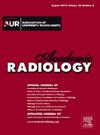Diagnostic Efficacy of Ventilation-Perfusion Single Photo Emission Computed Tomography/Computed Tomography for Pulmonary Hypertension due to Fibrinous Mediastinitis
IF 3.8
2区 医学
Q1 RADIOLOGY, NUCLEAR MEDICINE & MEDICAL IMAGING
引用次数: 0
Abstract
Rationale and Objectives
Comprehensive data on the use of ventilation-perfusion single-photo emission computed tomography/computed tomography (V/Q SPECT/CT), an established diagnostic tool for chronic thromboembolic pulmonary hypertension, in identifying pulmonary hypertension secondary to fibrinous mediastinitis (PH-FM) is scarce. This study aimed to assess its diagnostic efficacy for PH-FM.
Materials and Methods
Patients with PH due to pulmonary artery stenosis were assessed using V/Q SPECT/CT, computed tomography pulmonary angiography (CTPA), and digital subtraction pulmonary angiography (PAG). Abnormal mediastinal or hilar features identified by V/Q SPECT/CT, correlating with perfusion defects, were used to diagnose PH-FM. Final clinical diagnosis is recognized as the gold standard for this study. Diagnostic accuracy was compared using receiver operating characteristic (ROC) analysis and Cohen's kappa coefficient to evaluate agreement among the imaging methods.
Results
Among the patients included, 21 had PH-FM, and 76 had PH associated with non-FM. V/Q SPECT/CT showed higher sensitivity (90%), specificity (95%), and accuracy (94%) for detecting PH-FM compared to CTPA (sensitivity 86%, specificity 92%, accuracy 91%) and PAG (sensitivity 62%, specificity 87%, accuracy 81%). The areas under the ROC curve for V/Q SPECT/CT, CTPA, and PAG were 0.93, 0.89, and 0.74, respectively. V/Q SPECT/CT achieved better agreement with the gold standard than CTPA or PAG (κ = 0.82, κ = 0.69 and κ = 0.49, respectively).
Conclusion
V/Q SPECT/CT demonstrates superior diagnostic efficacy and accuracy compared to CTPA and PAG in diagnosing PH-FM.
Clinical Relevance Statement
Compared to computed tomography pulmonary angiography and digital subtraction pulmonary angiography, ventilation-perfusion single-photo emission computed tomography/computed tomography demonstrates superior diagnostic efficiency for pulmonary hypertension secondary to fibrinous mediastinitis, leading to improved early detection and accuracy, thus optimizing diagnostic pathways.
Key Points
- 1. Data on ventilation-perfusion single-photo emission computed tomography/computed tomography (V/Q SPECT/CT) demonstrates superior diagnostic efficiency for pulmonary hypertension secondary to fibrinous mediastinitis (PH-FM) was limited.
- 2. V/Q SPECT/CT exhibits perfect diagnostic accuracy in identifying PH-FM from chronic pulmonary vascular stenosis diseases.
- 3. V/Q SPECT/CT can early and accurately diagnose PH-FM, thus optimizing diagnostic pathways.
通气-灌注单光子发射计算机断层扫描/计算机断层扫描对纤维素性纵隔炎引起的肺动脉高压的诊断效果。
理由和目的:通气灌注单光发射计算机断层扫描/计算机断层扫描(V/Q SPECT/CT)是一种已建立的慢性血栓栓塞性肺动脉高压诊断工具,用于识别纤维性纵隔炎(PH-FM)继发肺动脉高压的综合数据很少。本研究旨在评价其对PH-FM的诊断效果。材料和方法:采用V/Q SPECT/CT、计算机断层肺血管造影(CTPA)和数字减影肺血管造影(PAG)对肺动脉狭窄引起的PH患者进行评估。通过V/Q SPECT/CT发现的与灌注缺陷相关的纵隔或肺门异常特征,用于诊断PH-FM。最终的临床诊断被认为是本研究的金标准。采用受试者工作特征(ROC)分析和Cohen’s kappa系数评价不同成像方法的一致性,比较诊断准确性。结果:本组患者中PH- fm 21例,PH合并非fm 76例。与CTPA(灵敏度86%,特异性92%,准确性91%)和PAG(灵敏度62%,特异性87%,准确性81%)相比,V/Q SPECT/CT检测PH-FM的灵敏度(90%)、特异性(95%)和准确性(94%)更高。V/Q SPECT/CT、CTPA、PAG的ROC曲线下面积分别为0.93、0.89、0.74。V/Q SPECT/CT与金标准的一致性优于CTPA和PAG (κ=0.82, κ=0.69和κ=0.49)。结论:与CTPA、PAG相比,V/Q SPECT/CT对PH-FM的诊断效率和准确性更高。临床相关性声明:与计算机断层肺血管造影和数字减影肺血管造影相比,通气-灌注单光发射计算机断层/计算机断层对纤维性纵隔炎继发肺动脉高压的诊断效率更高,提高了早期发现和准确性,从而优化了诊断途径。重点:
本文章由计算机程序翻译,如有差异,请以英文原文为准。
求助全文
约1分钟内获得全文
求助全文
来源期刊

Academic Radiology
医学-核医学
CiteScore
7.60
自引率
10.40%
发文量
432
审稿时长
18 days
期刊介绍:
Academic Radiology publishes original reports of clinical and laboratory investigations in diagnostic imaging, the diagnostic use of radioactive isotopes, computed tomography, positron emission tomography, magnetic resonance imaging, ultrasound, digital subtraction angiography, image-guided interventions and related techniques. It also includes brief technical reports describing original observations, techniques, and instrumental developments; state-of-the-art reports on clinical issues, new technology and other topics of current medical importance; meta-analyses; scientific studies and opinions on radiologic education; and letters to the Editor.
 求助内容:
求助内容: 应助结果提醒方式:
应助结果提醒方式:


